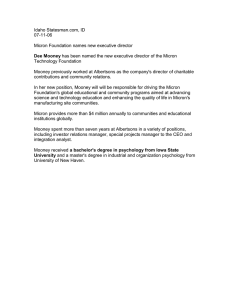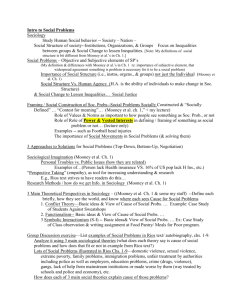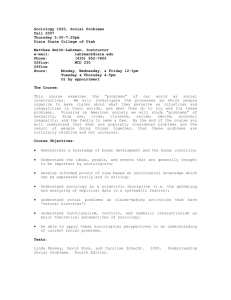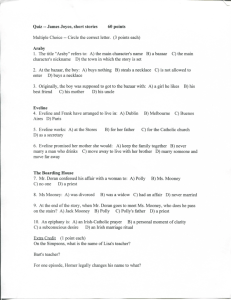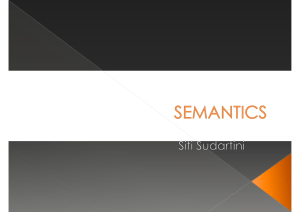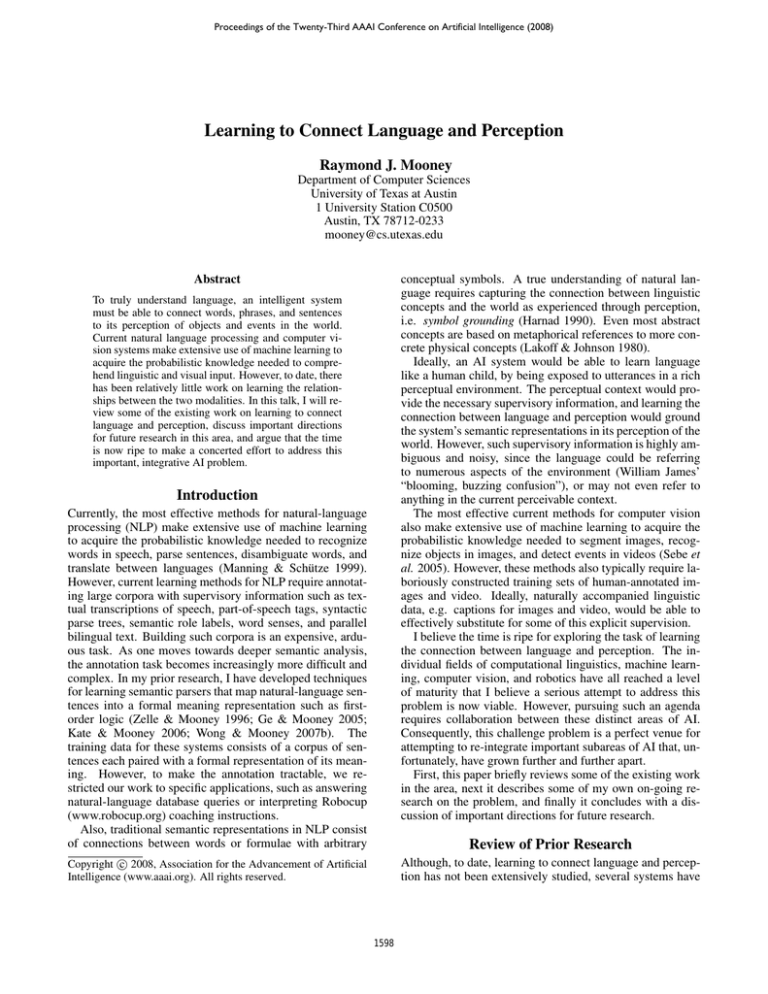
Proceedings of the Twenty-Third AAAI Conference on Artificial Intelligence (2008)
Learning to Connect Language and Perception
Raymond J. Mooney
Department of Computer Sciences
University of Texas at Austin
1 University Station C0500
Austin, TX 78712-0233
mooney@cs.utexas.edu
Abstract
conceptual symbols. A true understanding of natural language requires capturing the connection between linguistic
concepts and the world as experienced through perception,
i.e. symbol grounding (Harnad 1990). Even most abstract
concepts are based on metaphorical references to more concrete physical concepts (Lakoff & Johnson 1980).
Ideally, an AI system would be able to learn language
like a human child, by being exposed to utterances in a rich
perceptual environment. The perceptual context would provide the necessary supervisory information, and learning the
connection between language and perception would ground
the system’s semantic representations in its perception of the
world. However, such supervisory information is highly ambiguous and noisy, since the language could be referring
to numerous aspects of the environment (William James’
“blooming, buzzing confusion”), or may not even refer to
anything in the current perceivable context.
The most effective current methods for computer vision
also make extensive use of machine learning to acquire the
probabilistic knowledge needed to segment images, recognize objects in images, and detect events in videos (Sebe et
al. 2005). However, these methods also typically require laboriously constructed training sets of human-annotated images and video. Ideally, naturally accompanied linguistic
data, e.g. captions for images and video, would be able to
effectively substitute for some of this explicit supervision.
I believe the time is ripe for exploring the task of learning
the connection between language and perception. The individual fields of computational linguistics, machine learning, computer vision, and robotics have all reached a level
of maturity that I believe a serious attempt to address this
problem is now viable. However, pursuing such an agenda
requires collaboration between these distinct areas of AI.
Consequently, this challenge problem is a perfect venue for
attempting to re-integrate important subareas of AI that, unfortunately, have grown further and further apart.
First, this paper briefly reviews some of the existing work
in the area, next it describes some of my own on-going research on the problem, and finally it concludes with a discussion of important directions for future research.
To truly understand language, an intelligent system
must be able to connect words, phrases, and sentences
to its perception of objects and events in the world.
Current natural language processing and computer vision systems make extensive use of machine learning to
acquire the probabilistic knowledge needed to comprehend linguistic and visual input. However, to date, there
has been relatively little work on learning the relationships between the two modalities. In this talk, I will review some of the existing work on learning to connect
language and perception, discuss important directions
for future research in this area, and argue that the time
is now ripe to make a concerted effort to address this
important, integrative AI problem.
Introduction
Currently, the most effective methods for natural-language
processing (NLP) make extensive use of machine learning
to acquire the probabilistic knowledge needed to recognize
words in speech, parse sentences, disambiguate words, and
translate between languages (Manning & Schütze 1999).
However, current learning methods for NLP require annotating large corpora with supervisory information such as textual transcriptions of speech, part-of-speech tags, syntactic
parse trees, semantic role labels, word senses, and parallel
bilingual text. Building such corpora is an expensive, arduous task. As one moves towards deeper semantic analysis,
the annotation task becomes increasingly more difficult and
complex. In my prior research, I have developed techniques
for learning semantic parsers that map natural-language sentences into a formal meaning representation such as firstorder logic (Zelle & Mooney 1996; Ge & Mooney 2005;
Kate & Mooney 2006; Wong & Mooney 2007b). The
training data for these systems consists of a corpus of sentences each paired with a formal representation of its meaning. However, to make the annotation tractable, we restricted our work to specific applications, such as answering
natural-language database queries or interpreting Robocup
(www.robocup.org) coaching instructions.
Also, traditional semantic representations in NLP consist
of connections between words or formulae with arbitrary
Review of Prior Research
Although, to date, learning to connect language and perception has not been extensively studied, several systems have
c 2008, Association for the Advancement of Artificial
Copyright Intelligence (www.aaai.org). All rights reserved.
1598
been developed that infer grounded meanings of individual
words or descriptive phrases from their visual context. Deb
Roy and his research group have built several robots that
learn linguistic descriptions of objects (Roy 2005). In particular, he has shown that by detecting correlations between
audio and visual modalities in the context of infant-directed
speech, that a system could learn to segment speech into discrete words more accurately than using audio input alone
(Roy & Pentland 2002). Roy (2002) also developed a system that learns to describe simple geometrical figures in an
image based on their size, color, and shape as well as their
location relative to other figures in the scene.
Yu and Ballard (2004) have also developed methods that
learn to associate nouns with the perception of particular objects. The NLT group at Berkeley has worked on learning
linguistic descriptions of “blocks world” scenes (Feldman
et al. 1996). Barnard et al. (2003) developed a method
that learns to associate words with image regions or complete pictures by training on captioned images. Barnard and
Johnson (2005) present a method that learns to choose the
correct sense of an ambiguous word based on an accompanying image, such as picking a meaning for “bank” when it
is paired with either a picture of a building or a river. There
is also a growing body of recent work in computer vision
that uses text captions to help classify and cluster images
on the web, e.g. (Bekkerman & Jeon 2007). However the
language used in existing work is quite restrictive and the
vision, neural-net, and robotics researchers who have conducted this research did not exploit the latest statistical NLP
methods for learning complex natural-language grammar.
Figure 1: Screenshot of our Robocup Sportscasting System
The system uses ideas from our system K RISPER (Kate
& Mooney 2007) to learn from the weakly-supervised, ambiguous training data. K RISP (Kate & Mooney 2006) uses
support-vector machines (SVMs) with string kernels (Lodhi
et al. 2002) to learn semantic parsers. K RISPER extends
K RISP to handle ambiguous training data, in which each
natural-language (NL) sentence is annotated only with a set
of potential meaning representations (MRs), only one of
which is correct. It employs an iterative approach analogous to expectation maximization (EM) that improves upon
the selection of the correct NL–MR pairs in each iteration.
In the first iteration, it assumes that all of the MRs paired
with a sentence are correct and trains K RISP with the resulting noisy supervision. In subsequent iterations, K RISPER
uses the currently trained parser to score each potential NL–
MR pair, selects the most likely MR for each sentence, and
retrains the parser.
Our sportscasting system also uses ideas from our system WASP (Wong & Mooney 2006; 2007b) in order to learn
how to generate language as well as to parse it. WASP uses
statistical machine translation (SMT) techniques to induce
a probabilistic synchronous context-free grammar (PSCFG)
(Wu 1997) to translate NL sentences into logical MRs. The
PSCFG is learned using a modification of recent methods in
syntax-based SMT (Chiang 2005). Since a PSCFG is symmetric with respect to input/output, the same learned model
can also be used to generate NL sentences from formal MRs.
Thus, WASP learns a PSCFG that supports both semantic
parsing and natural language generation. By using the EMlike retraining procedure used in K RISPER, we developed a
version of WASP that learns to parse and generate language
given only ambiguous training data.
However, a language generator alone is not enough to produce a sportscast. In addition to knowing how to say something, one must also know what to say. A sportscaster must
also choose which events to describe. In NLP, deciding what
to say is called strategic generation. We also developed
a simple approach to learn, from the available ambiguous
Our Current Research
As an initial test of grounded language learning, we have
recently developed a system that learns to sportscast simulated soccer games by training on sample “play by play”
commentaries (Chen & Mooney 2008). We decided to initially study the problem in a simulated environment that retains the properties of a dynamic world with multiple agents
and actions while avoiding the complexities of computer vision. Specifically, we use the Robocup simulator1 which
provides a fairly detailed physical simulation of robot soccer. Our system learns to interpret and generate language
in the Robocup domain by observing on-going textual commentary on a game together with the evolving state of the
simulator. By exploiting existing techniques for abstracting a symbolic description of the activity on the field from
the simulator state (André et al. 2000), we obtain a pairing of natural language with a symbolic description of the
perceptual context in which it was uttered. However, such
training data is highly ambiguous because a typical comment co-occurs with multiple events to which it could refer. We enhanced our existing methods for learning semantic parsers and language generators (Kate & Mooney 2007;
Wong & Mooney 2007a) in order to learn to understand
and produce language from such ambiguous training data.
A screenshot of our system with generated commentaries is
shown in Figure 1.
1
http://sourceforge.net/projects/sserver/
1599
ular, there has been significant recent progress in identifying intentional human actions in video input (Fern, Givan,
& Siskind 2002; Aggarwal & Park 2004); however, significant additional development is required to extract the range
of objects and events to which language can refer. Ideally,
methods are needed for using naturally accompanying linguistic clues as a substitute for explicit supervisory labels.
Finally, good testbeds and datasets are needed that can
serve as shared experimental benchmarks. Simulated environments, like that used in our Robocup sportscasting task,
will be useful for studying the NLP and learning issues without first having to solve all of the difficult computer vision
problems. In particular, interactive video-games can provide
rich simulated environments for grounded language learning
(Fleischman & Roy 2005; Gorniak & Roy 2005). Another
promising benchmark is learning from the language and corresponding drawings in children’s picture books. Images
and video with text captions can also provide a rich source
of useful data, e.g. (Fleischman & Roy 2007).
In conclusion, I believe that learning to connect language and perception raises a number of interesting challenge problems that requires integrating ideas and methods
from machine learning, NLP, computer vision, and robotics.
I believe that substantial progress can be made on these important problems in the ensuing years, and I would encourage others to join me in exploring this exciting research direction.
training data, the types of events that a sportscaster is most
likely to describe.
To train and test our system, we assembled commentated soccer games from the Robocup simulation league
(www.robocup.org) by having humans commentate games
while watching them on the simulator. We annotated a total
of four games, namely, the finals for each year from 2001
to 2004. We then trained our system on three games and
tested it on the fourth game, averaging over the four possible test games. We evaluated how well the system learned to
parse sentences into MRs and generate language describing
game events, as well as its ability to determine which sentences referred to which game events and to decide which
game events to comment on. We also presented human evaluators a random mix of human-commentated and machinecommentated game clips and asked them to subjectively rate
their quality on a 5-point scale. On average, the machinecommentated clips received a score only 0.7 points below
the human ones. Although we did not quite achieve humanlevel performance, we believe the results clearly demonstrate that our system can effectively perform grounded language learning from a very limited amount of realistic training data. Chen and Mooney (2008) present the detailed results.
Directions for Future Research
There are important problems in each of the areas of NLP,
machine learning, and computer vision that need to be addressed to make progress on the proposed challenge, with
the eventual goal of integrating the techniques developed.
From NLP, effective methods are needed for learning from
language paired with semantic representations. This has
been one of the foci of my own research over the last decade,
and a few other researchers have started to explore the problem (Zettlemoyer & Collins 2005).
From machine learning, methods are needed that can
learn from highly ambiguous training data in which sentences are paired with many potential meanings only one
(if any) of which is correct. A few initial approaches to
handling such referential uncertainty or ambiguous training
data have been proposed (Siskind 1996; Kate & Mooney
2007); however, methods are needed that exploit more clues
and constraints, such as those studied in psychological research on child language acquisition (Bloom 2000). Another
interesting connection that should be explored is the one between language learning from such ambiguous supervision
and multiple instance learning (MIL) (Dietterich, Lathrop,
& Lozano-Perez 1997; Ray & Craven 2005). In multiple instance learning, weak supervision is provided in the form of
“bags” of instances of which at least one is guaranteed to be
a positive example of the target concept. If given sentences
with sets of possible meaning representations, it constitutes
a form of MIL for learning with structured data (Bakir et
al. 2007). In this case, training consists of input strings each
paired with a set of possible structured meaning representations of which at exactly one is correct. To my knowledge,
there is currently no work on MIL for structured output.
From computer vision, methods are needed for learning
to recognize objects and events from visual input. In partic-
Acknowledgements
I would like to thank my current and former graduate students, John Zelle, Cindi Thompson, Yuk Wah (John) Wong,
Rohit Kate, Ruifang Ge, and David Chen for contributing
substantially to the work described in this paper. This research was supported by the National Science Foundation
through grant IIS–0712097.
References
Aggarwal, J. K., and Park, S. 2004. Human motion: Modeling and recognition of actions and interactions. In Proceedings of the 2nd International Symposium on 3D Data
Processing, Visualization, and Transmission.
André, E.; Binsted, K.; Tanaka-Ishii, K.; Luke, S.; Herzog,
G.; and Rist, T. 2000. Three RoboCup simulation league
commentator systems. AI Magazine 21(1):57–66.
Bakir, G.; Hoffman, T.; Schölkopf, B.; Smola, A. J.;
Taskar, B.; and Vishwanathan, S. V. N., eds. 2007. Predicting Structured Data. Cambridge, MA: MIT Press.
Barnard, K., and Johnson, M. 2005. Word sense disambiguation with pictures. Artificial Intelligence 167:13–30.
Barnard, K.; Duygulu, P.; Forsyth, D.; de Freitas, N.; Blei,
D. M.; and Jordan, M. I. 2003. Matching words and
pictures. Journal of Machine Learning Research 3:1107–
1135.
Bekkerman, R., and Jeon, J. 2007. Multi-modal clustering for multimedia collections. In IEEE Computer Society
Conference on Computer Vision and Pattern Recognition.
1600
Ray, S., and Craven, M. 2005. Supervised versus multiple
instance learning: An empirical comparison. In Proceedings of 22nd International Conference on Machine Learning (ICML-2005), 697–704.
Roy, D. K., and Pentland, A. P. 2002. Learning words
from sights and sounds: a computational model. Cognitive
Science 26:113–146.
Roy, D. 2002. Learning visually grounded words and syntax for a scene description task. Computer Speech and Language 16(3):353–385.
Roy, D. 2005. Grounding words in perception and action:
Insights from computational models. Trends in Cognitive
Science 9(8):389–396.
Sebe, N.; Cohen, I.; Garg, A.; and Huang, T. 2005. Machine Learning in Computer Vision. Berlin: Springer Verlag.
Siskind, J. M. 1996. A computational study of crosssituational techniques for learning word-to-meaning mappings. Cognition 61(1):39–91.
Wong, Y., and Mooney, R. J. 2006. Learning for semantic
parsing with statistical machine translation. In Proceedings of Human Language Technology Conference / North
American Chapter of the Association for Computational
Linguistics Annual Meeting (HLT-NAACL-06), 439–446.
Wong, Y., and Mooney, R. J. 2007a. Generation by inverting a semantic parser that uses statistical machine translation. In Proceedings of Human Language Technologies:
The Conference of the North American Chapter of the Association for Computational Linguistics (NAACL-HLT-07),
172–179.
Wong, Y., and Mooney, R. J. 2007b. Learning synchronous
grammars for semantic parsing with lambda calculus. In
Proceedings of the 45th Annual Meeting of the Association
for Computational Linguistics (ACL-07), 960–967.
Wu, D. 1997. Stochastic inversion transduction grammars
and bilingual parsing of parallel corpora. Computational
Linguistics 23(3):377–403.
Yu, C., and Ballard, D. H. 2004. On the integration of
grounding language and learning objects. In Proceedings
of the Nineteenth National Conference on Artificial Intelligence (AAAI-2004), 488–493.
Zelle, J. M., and Mooney, R. J. 1996. Learning to parse
database queries using inductive logic programming. In
Proceedings of the Thirteenth National Conference on Artificial Intelligence (AAAI-96), 1050–1055.
Zettlemoyer, L. S., and Collins, M. 2005. Learning to map
sentences to logical form: Structured classification with
probabilistic categorial grammars. In Proceedings of 21th
Conference on Uncertainty in Artificial Intelligence (UAI2005).
Bloom, P. 2000. How Children Learn the Meanings of
Words. Cambridge, MA: MIT Press.
Chen, D. L., and Mooney, R. J. 2008. Learning to
sportscast: A test of grounded language acquisition. In
Proceedings of 25th International Conference on Machine
Learning (ICML-2008).
Chiang, D. 2005. A hierarchical phrase-based model for
statistical machine translation. In Proceedings of the 43nd
Annual Meeting of the Association for Computational Linguistics (ACL-05), 263–270.
Dietterich, T. G.; Lathrop, R. H.; and Lozano-Perez, T.
1997. Solving the multiple instance problem with axisparallel rectangles. Artificial Intelligence 89(1-2):31–71.
Feldman, J. A.; Lakoff, G.; Bailey, D. R.; Narayanan, S.;
Regier, T.; and Stolcke, A. 1996. L0 – the first five years
of an automated language acquisition project. AI Review 8.
Fern, A.; Givan, R.; and Siskind, J. M. 2002. Specificto-general learning for temporal events with application to
learning event definitions from video. Journal of Artificial
Intelligence Research 17:379–449.
Fleischman, M., and Roy, D. 2005. Intentional context
in situated natural language learning. In Proceedings of
the Ninth Conference on Computational Natural Language
Learning (CoNLL-2005), 104–111.
Fleischman, M., and Roy, D. 2007. Situated models of
meaning for sports video retrieval. In Proceedings of Human Language Technologies: The Conference of the North
American Chapter of the Association for Computational
Linguistics (NAACL-HLT-07).
Ge, R., and Mooney, R. J. 2005. A statistical semantic
parser that integrates syntax and semantics. In Proceedings of the Ninth Conference on Computational Natural
Language Learning (CoNLL-2005), 9–16.
Gorniak, P., and Roy, D. 2005. Speaking with your sidekick: Understanding situated speech in computer role playing games. In Proceedings of the 4th Conference on Artificial Intelligence and Interactive Digital Entertainment.
Harnad, S. 1990. The symbol grounding problem. Physica
D 42:335–346.
Kate, R. J., and Mooney, R. J. 2006. Using stringkernels for learning semantic parsers. In Proceedings of
the 21st International Conference on Computational Linguistics and 44th Annual Meeting of the Association for
Computational Linguistics (COLING/ACL-06), 913–920.
Kate, R. J., and Mooney, R. J. 2007. Learning language
semantics from ambiguous supervision. In Proceedings
of the Twenty-Second Conference on Artificial Intelligence
(AAAI-2007), 895–900.
Lakoff, G., and Johnson, M. 1980. Metaphors We Live By.
Chicago: University Of Chicago Press.
Lodhi, H.; Saunders, C.; Shawe-Taylor, J.; Cristianini, N.;
and Watkins, C. 2002. Text classification using string kernels. Journal of Machine Learning Research 2:419–444.
Manning, C. D., and Schütze, H. 1999. Foundations of
Statistical Natural Language Processing. Cambridge, MA:
MIT Press.
1601


